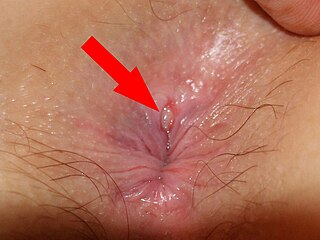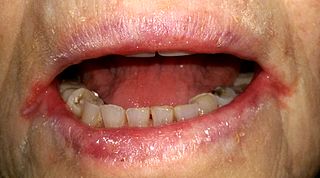Related Research Articles

In articulatory phonetics, the place of articulation of a consonant is a location along the vocal tract where its production occurs. It is a point where a constriction is made between an active and a passive articulator. Active articulators are organs capable of voluntary movement which create the constriction, while passive articulators are so called because they are normally fixed and are the parts with which an active articulator makes contact. Along with the manner of articulation and phonation, the place of articulation gives the consonant its distinctive sound.

In pharmacology and toxicology, a route of administration is the way by which a drug, fluid, poison, or other substance is taken into the body.

An anal fissure is a break or tear in the skin of the anal canal. Anal fissures may be noticed by bright red anal bleeding on toilet paper and undergarments, or sometimes in the toilet. If acute they are painful after defecation, but with chronic fissures, pain intensity often reduces. Anal fissures usually extend from the anal opening and are usually located posteriorly in the midline, probably because of the relatively unsupported nature and poor perfusion of the anal wall in that location. Fissure depth may be superficial or sometimes down to the underlying sphincter muscle. Untreated fissures develop a hood-like skin tag which cover the fissure and cause discomfort and pain.
ATC code C01Cardiac therapy is a therapeutic subgroup of the Anatomical Therapeutic Chemical Classification System, a system of alphanumeric codes developed by the World Health Organization (WHO) for the classification of drugs and other medical products. Subgroup C01 is part of the anatomical group C Cardiovascular system.
ATC code C05Vasoprotectives is a therapeutic subgroup of the Anatomical Therapeutic Chemical Classification System, a system of alphanumeric codes developed by the World Health Organization (WHO) for the classification of drugs and other medical products. Subgroup C05 is part of the anatomical group C Cardiovascular system.
Dipping tobacco is a type of finely ground or shredded, moistened smokeless tobacco product. It is commonly and idiomatically known as "dip". Dipping tobacco is used by placing a pinch, or "dip", of tobacco between the lip and the gum. The act of using it is called dipping. Dip is colloquially called "chaw", "snuff", "rub", or "fresh leaf" among other terms; because of this, it is sometimes confused with other tobacco products—namely nasal/dry snuff.
The oral mucosa is the mucous membrane lining the inside of the mouth. It comprises stratified squamous epithelium, termed "oral epithelium", and an underlying connective tissue termed lamina propria. The oral cavity has sometimes been described as a mirror that reflects the health of the individual. Changes indicative of disease are seen as alterations in the oral mucosa lining the mouth, which can reveal systemic conditions, such as diabetes or vitamin deficiency, or the local effects of chronic tobacco or alcohol use. The oral mucosa tends to heal faster and with less scar formation compared to the skin. The underlying mechanism remains unknown, but research suggests that extracellular vesicles might be involved.

Triacetin is the organic compound with the formula C3H5(OCOCH3)3. It is classified as a triglyceride, i.e., the triester of glycerol with acetic acid. It is a colorless, viscous, and odorless liquid with a high boiling point and a low melting point. It has a mild, sweet taste in concentrations lower than 500 ppm, but may appear bitter at higher concentrations. It is one of the glycerine acetate compounds.
Sublingual, from the Latin for "under the tongue", refers to the pharmacological route of administration by which substances diffuse into the blood through tissues under the tongue.

Angular cheilitis (AC) is inflammation of one or both corners of the mouth. Often the corners are red with skin breakdown and crusting. It can also be itchy or painful. The condition can last for days to years. Angular cheilitis is a type of cheilitis.

Nitroglycerin, also known as glyceryl trinitrate (GTN), is a vasodilator used for heart failure, high blood pressure (hypertension), anal fissures, painful periods, and to treat and prevent chest pain caused by decreased blood flow to the heart (angina) or due to the recreational use of cocaine. This includes chest pain from a heart attack. It is taken by mouth, under the tongue, applied to the skin, or by injection into a vein.

This article describes the anatomy of the head and neck of the human body, including the brain, bones, muscles, blood vessels, nerves, glands, nose, mouth, teeth, tongue, and throat.
Dosage forms are pharmaceutical drug products in the form in which they are marketed for use, with a specific mixture of active ingredients and inactive components (excipients), in a particular configuration, and apportioned into a particular dose. For example, two products may both be amoxicillin, but one is in 500 mg capsules and another is in 250 mg chewable tablets. The term unit dose can also sometimes encompass non-reusable packaging as well, although the FDA distinguishes that by unit-dose "packaging" or "dispensing". Depending on the context, multi(ple) unit dose can refer to distinct drug products packaged together, or to a single drug product containing multiple drugs and/or doses. The term dosage form can also sometimes refer only to the pharmaceutical formulation of a drug product's constituent drug substance(s) and any blends involved, without considering matters beyond that. Because of the somewhat vague boundaries and unclear overlap of these terms and certain variants and qualifiers within the pharmaceutical industry, caution is often advisable when conversing with someone who may be unfamiliar with another person's use of the term.
Oral and maxillofacial pathology refers to the diseases of the mouth, jaws and related structures such as salivary glands, temporomandibular joints, facial muscles and perioral skin. The mouth is an important organ with many different functions. It is also prone to a variety of medical and dental disorders.

A nitrovasodilator is a pharmaceutical agent that causes vasodilation by donation of nitric oxide (NO), and is mostly used for the treatment and prevention of angina pectoris.

Crack cocaine, commonly known simply as crack, and also known as rock, is a free base form of the stimulant cocaine that can be smoked. Crack offers a short, intense high to smokers. The Manual of Adolescent Substance Abuse Treatment calls it the most addictive form of cocaine.

Anilingus is an oral and anal sex act in which a person stimulates the anus of another by using the tongue and lips. It is also called anal–oral contact and anal–oral sex.

A transdermal analgesic or pain relief patch is a medicated adhesive patch used to relieve minor to severe pain. There are many types of analgesic patches based on the main ingredients in the patches. These include patches containing counterirritants, which are used to treat mild to moderate pain, and patches containing opioids such as buprenorphine and fentanyl, used to relieve moderate to severe pain. Fentanyl is often used for opioid-tolerant patients. Nitroglycerin, also known as glyceryl trinitrate (GTN), a medication used for heart failure, high blood pressure, anal fissures, painful periods, and to treat and prevent chest pain, can also be found in patches. Beyond these are patches that contain drugs such as diclofenac and lidocaine and various other drugs. The main purpose of transdermal analgesic patches are to administer drugs in a more viable way to patients, as opposed to oral consumption or intravenous administration such as an injection.

Oral administration is a route of administration whereby a substance is taken through the mouth, swallowed, and then processed via the digestive system. This is a common route of administration for many medications.
Buccal administration is a topical route of administration by which drugs held or applied in the buccal area diffuse through the oral mucosa and enter directly into the bloodstream. Buccal administration may provide better bioavailability of some drugs and a more rapid onset of action compared to oral administration because the medication does not pass through the digestive system and thereby avoids first pass metabolism.
References
- ↑ FASS.se (Farmaceutiska Specialiteter i Sverige – the Swedish official drug catalog) > Suscard (Glyceryl trinitrate) Retrieved on April 25, 2010





